
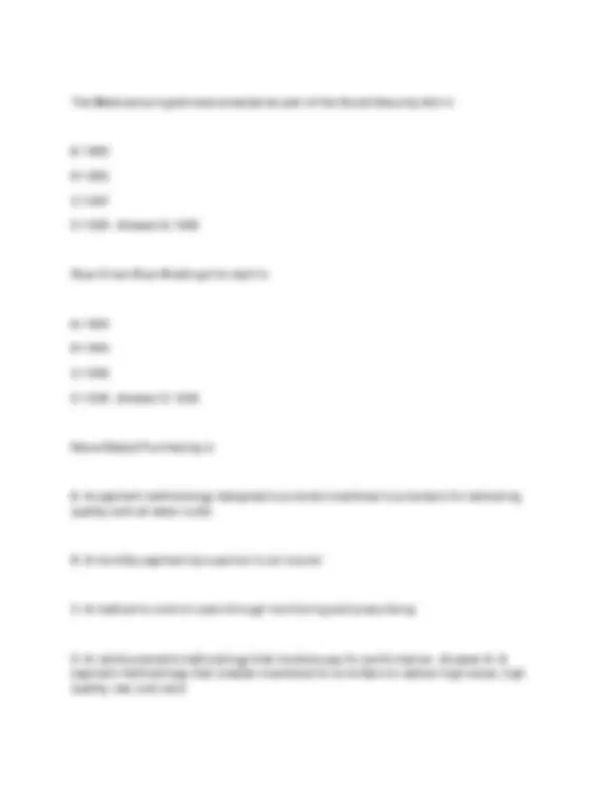
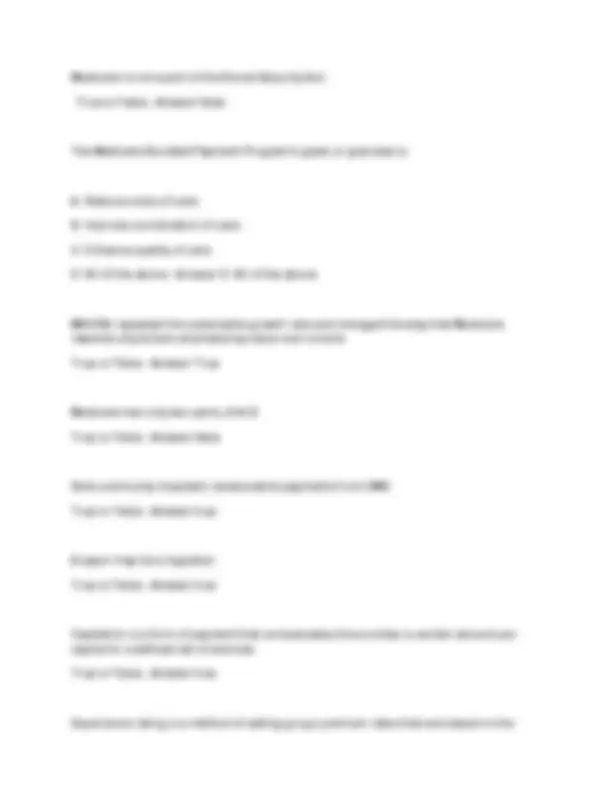
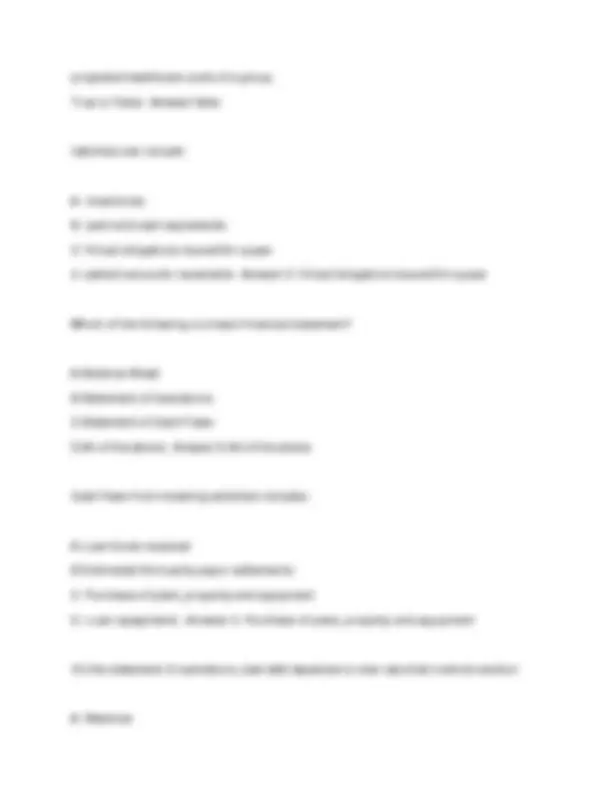
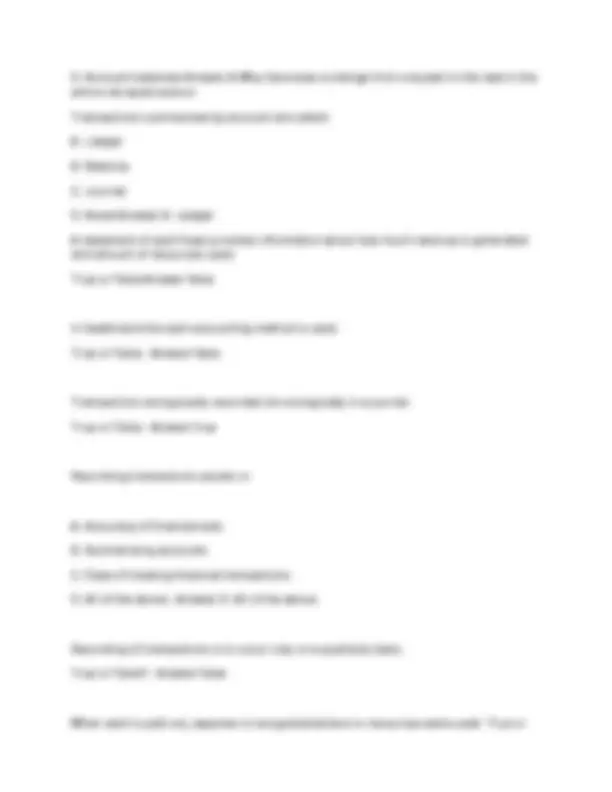
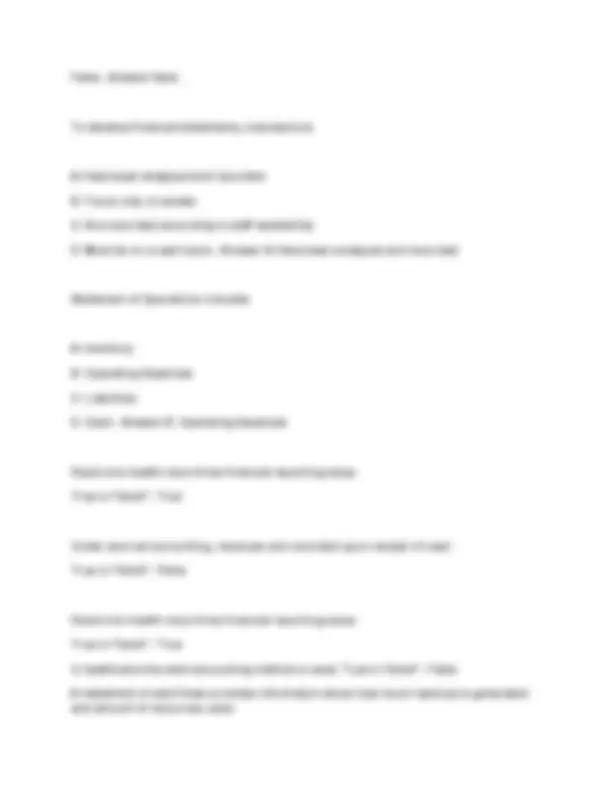
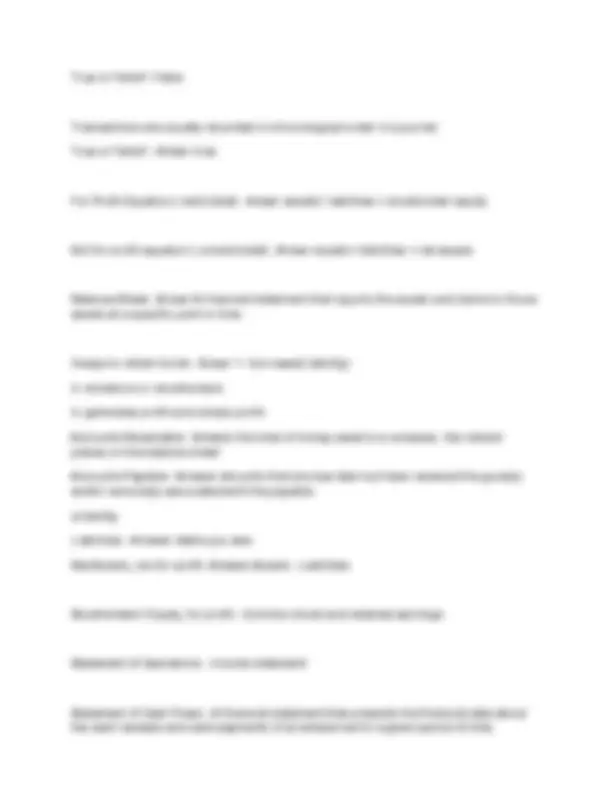
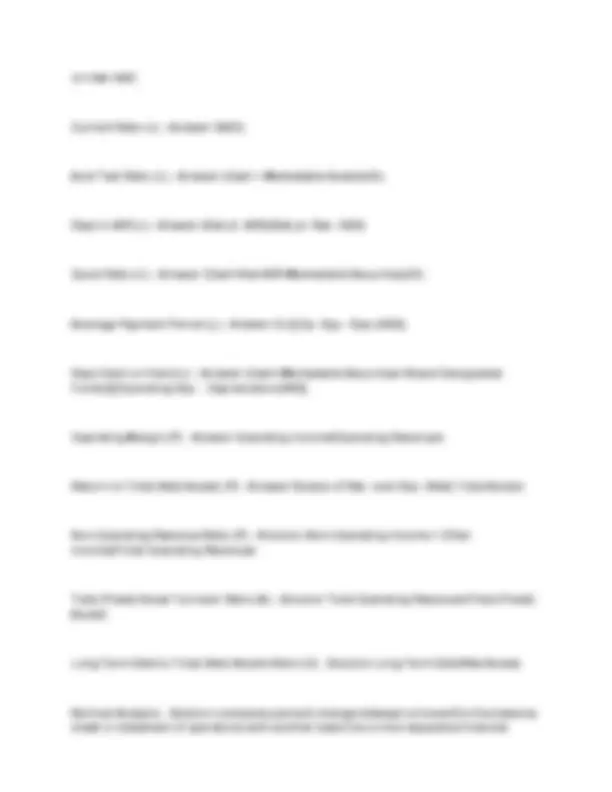
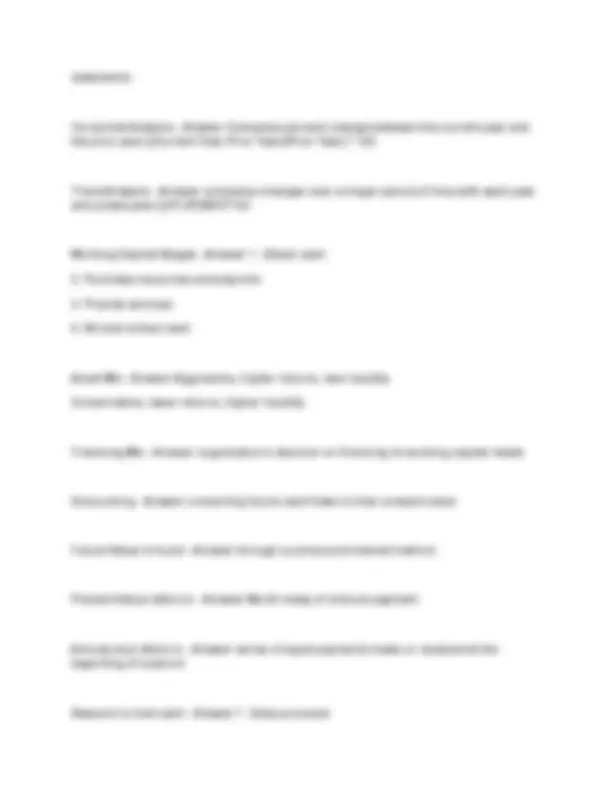
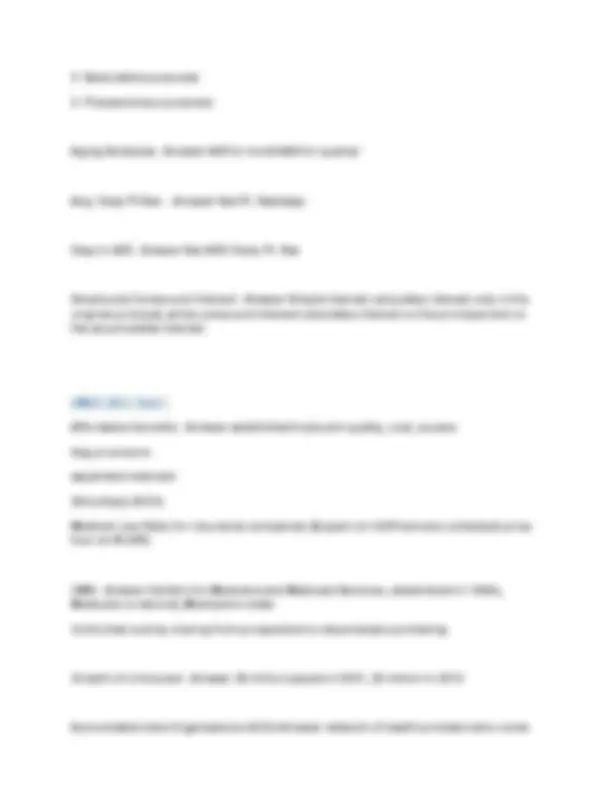
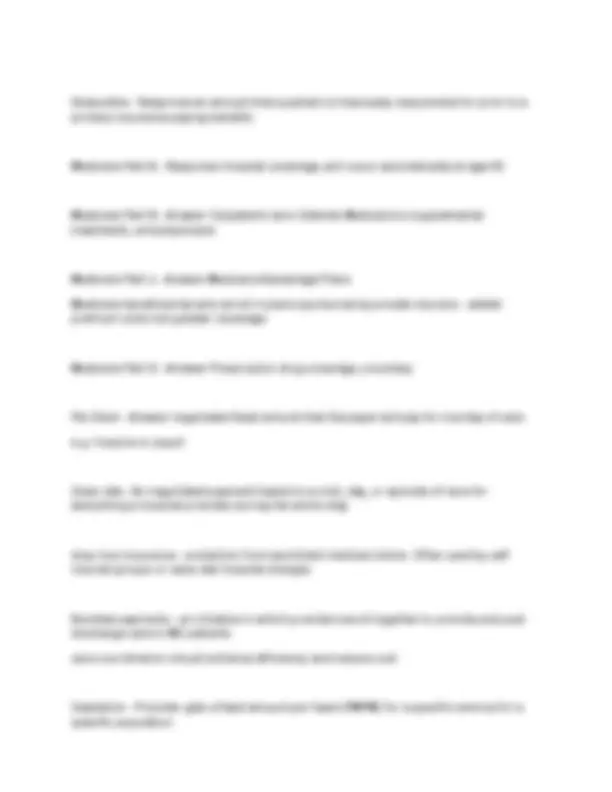
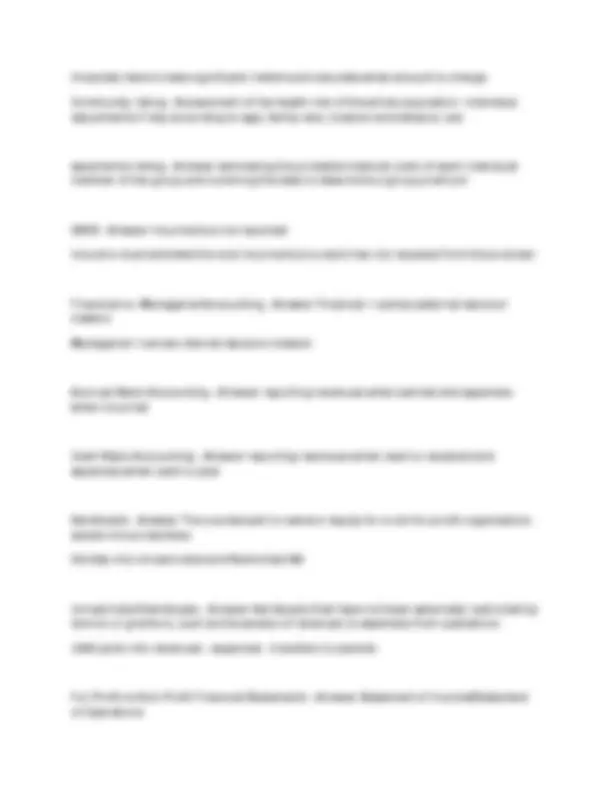
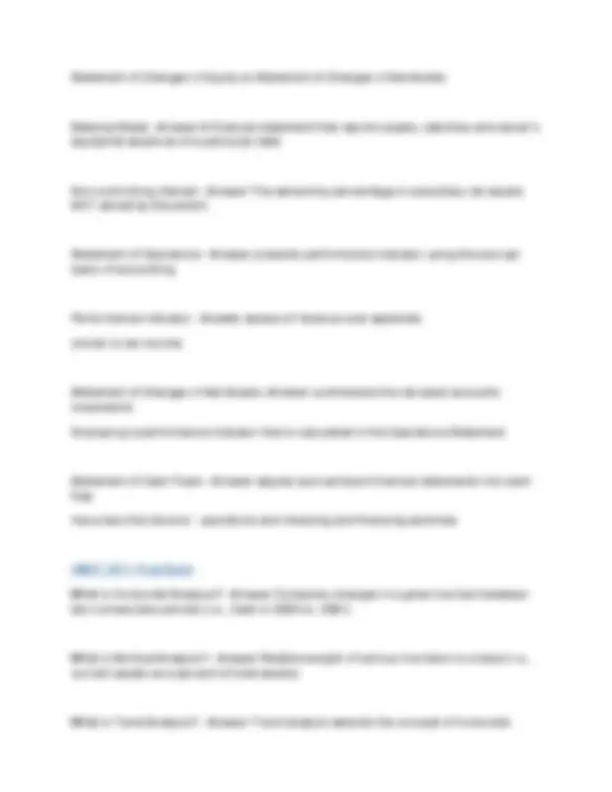
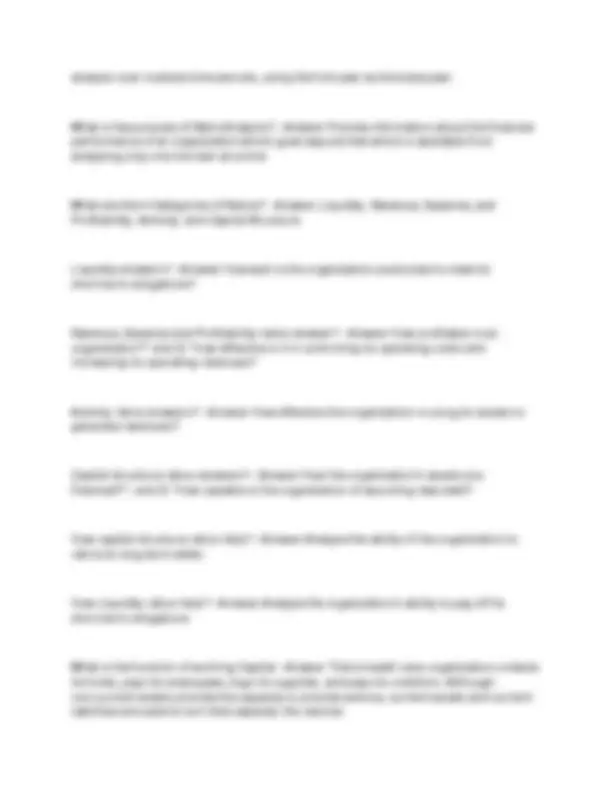

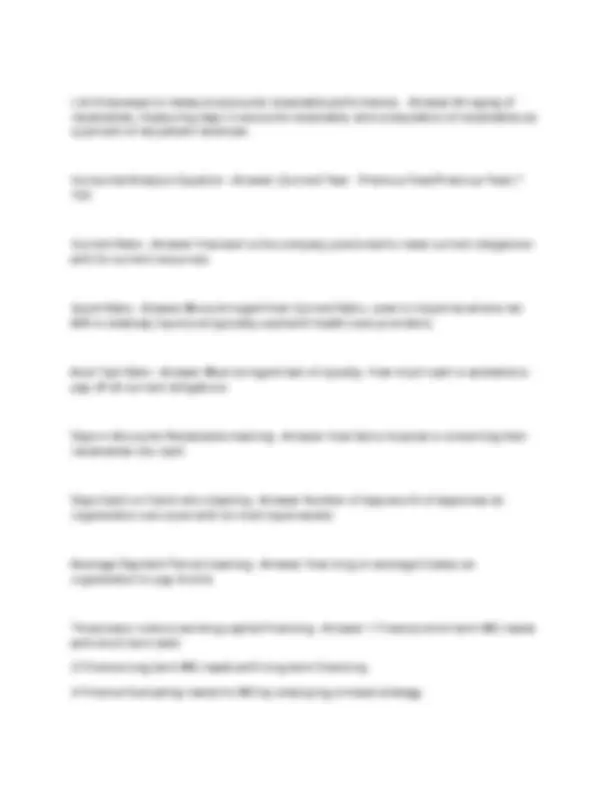
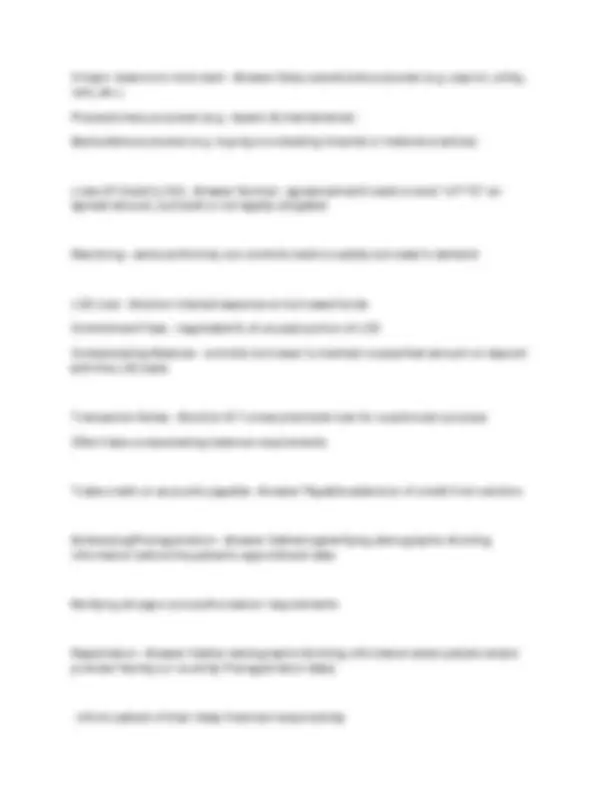
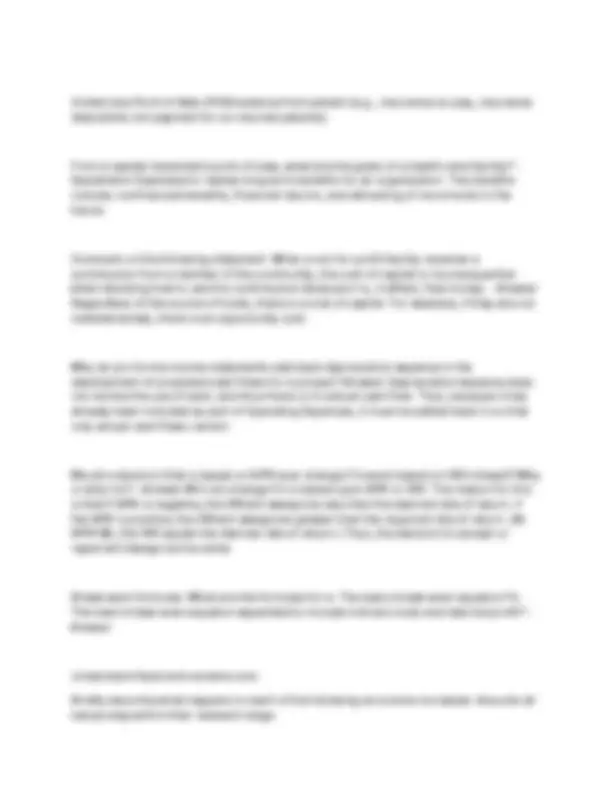
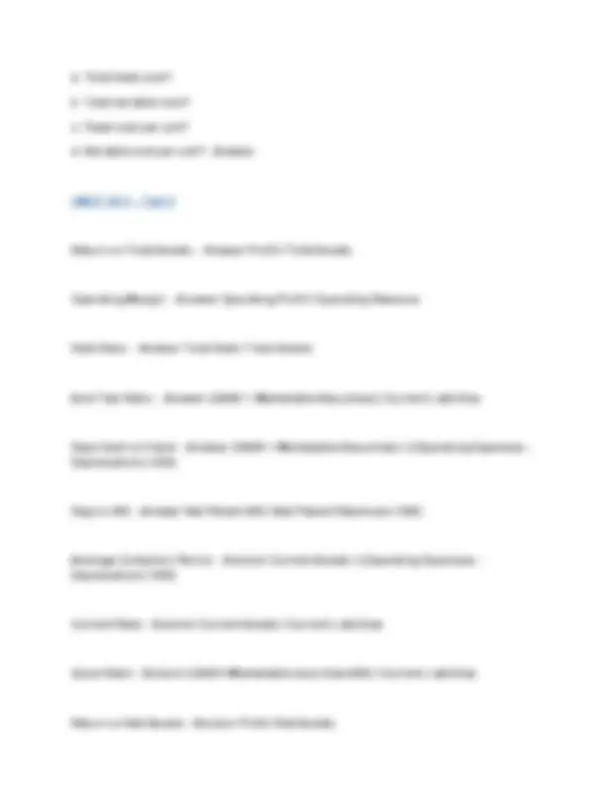
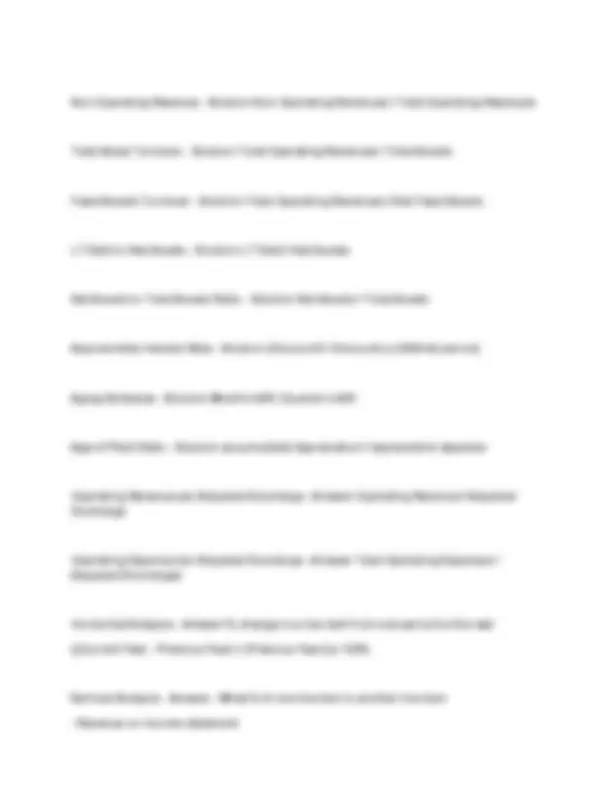
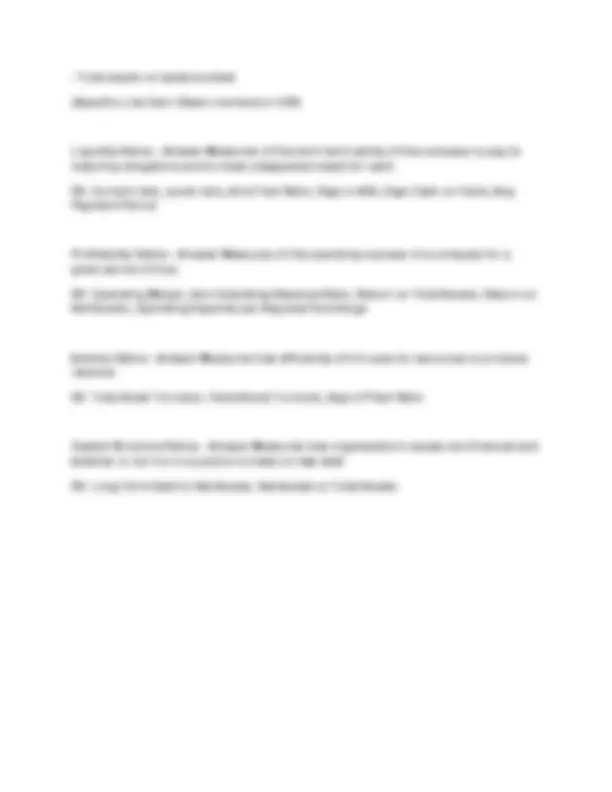


Study with the several resources on Docsity

Earn points by helping other students or get them with a premium plan


Prepare for your exams
Study with the several resources on Docsity

Earn points to download
Earn points by helping other students or get them with a premium plan
Community
Ask the community for help and clear up your study doubts
Discover the best universities in your country according to Docsity users
Free resources
Download our free guides on studying techniques, anxiety management strategies, and thesis advice from Docsity tutors
A collection of multiple-choice questions and answers related to hmgt 3311, a course likely focused on healthcare management. It covers topics such as the affordable care act (aca), healthcare financing, medicare, medicaid, and financial accounting principles. The questions offer a basic understanding of key concepts in healthcare management, but lack in-depth analysis or application of these concepts.
Typology: Exams
1 / 28

This page cannot be seen from the preview
Don't miss anything!





















3311 Exam II Review, HMGT 3311 Test 1, HMGT 3311 Final Exam and HMGT 3311 - Test 2)
HMGT 3311 Exam 1, HMGT 3311 Exam II Review, HMGT 3311 Test 1, HMGT 3311 Final Exam and HMGT 3311 - Test 2
HMGT 3311 Exam 1 Litigation under ACA was sufficiently addressed true or false - Answer false ICD-10 as a coding system has been used in the United States for many years. True orfalse - Answer false
Retail Health Care is not viable in today's health care environment. true or false - Answer false ACOs are voluntary groups of health care providers who coordinate care to a patientpopulation true or false - Answer true Value Based Payment has always been a part of Medicare. True or false - Answer false ACA is an acronym for what legislation? A.Patient Protection and Affordable Care Act
B.Accountable Care Organizations C.Activity Based Costing D.Administrative Cost Accounting - Answer A.Patient Protection and Affordable CareAct
ACA offers a _______________ benefits package: A. zeroB. $5, C. Minimum D. Maximum - Answer C. Minimum Which one of the following factors below is NOT a contributing factor in the increasingcost of healthcare?
A.Aging population B.New and returning consumers in the marketplaceC. Chronic Disease D.Providers embracing lean Six Sigma and other techniques to deliver better care withless resources - Answer D.Providers embracing lean Six Sigma and other techniques to deliver better care with less resources APCs are a _________ payment mechanism for outpatient services delivered at ahospital.
A.value based B.cost based C.prospectiveD.Retrospective - Answer C.prospective
Medicare is not a part of the Social Security Act. True or False - Answer false The Medicare Bundled Payment Program's goals or goal was to A. Reduce costs of care B. Improve coordination of care C. Enhance quality of careD. All of the above - Answer D. All of the above
MACRA repealed the sustainable growth rate and changed the way that Medicarerewards physicians emphasizing value over volume True or False - Answer True Medicare has only two parts, A & B. True or False - Answer false Sole community hospitals receive extra payments from CMS True or False - Answer true A payor may be a regulator. True or False - Answer true Capitation is a form of payment that compensates the provider a certain amount percapita for a defined set of services. True or False - Answer true Experience rating is a method of setting group premium rates that are based on the
projected healthcare costs of a group. True or False - Answer false liabilities can include: A. inventories B. cash and cash equivalents C. finical obligations due within a yeard. patient accounts receivable - Answer C. finical obligations due within a year
Which of the following is a basic financial statement? A.Balance Sheet B.Statement of OperationsC.Statement of Cash Flows D.All of the above - Answer D.All of the above Cash flows from investing activities includes: A Loan funds receivedB.Estimated third party payor settlements C. Purchase of plant, property and equipment D. Loan repayments - Answer C. Purchase of plant, property and equipment On the statement of operations, bad debt expenses is now reported in which section: A. Revenue
C. Statement of Changes in Net Assets D. None of the above - Answer C. Statement of Changes in Net Assets Other revenue could include all of the following except: A. Salary and wages B.Income from investments C.Revenue from contributionsD. Appropriations and grants - Answer A. Salary and wages
Balance Sheet for a non-profit contains all of the following except: A.Organization's liabilities B.CashC. Organization's assets D. Stockholders' equity - Answer D. Stockholders' equity GAAP requires certain disclosure (notes to financial statements) to give greaterdisclosure of the financial position.
True or False - Answer true The statement of changes in net assets includes: A.Why there was a change from one year to the next in the entire net asset section of thebalance sheet B. Accounting Methods C. Expense determinations
D. Account balances Answer A.Why there was a change from one year to the next in theentire net asset section Transactions summarized by account are called:A. Ledger B. Balance C. JournalD. Asset Answer A. Ledger A statement of cash flows provides information about how much revenue is generatedand amount of resources used. True or False Answer false In healthcare the cash accounting method is used. True or False - Answer false Transactions are typically recorded chronologically in a journal. True or False - Answer true Recording transactions assists in: A. Accuracy of financial actsB. Summarizing accounts C. Ease of tracking financial transactionsD. All of the above - Answer D. All of the above
Recording of transactions is to occur only on a quarterly basis.True or False? - Answer false
When cash is paid out, expense is recognized where no resources were used. True or
True or False? -False Transactions are usually recorded in chronological order in a journal.True or False? - Answr true
For Profit Equation ( restricted) - Answr assets= liabilities + stockholder equity Not for profit equation ( unrestricted) - Answr assets= liabilities + net assets Balance Sheet - Answr A financial statement that reports the assets and claims to thoseassets at a specific point in time.
3 ways to obtain funds - Answr 1- borrowed( liability) 2- donations or stockholders3- generates profit and utilizes profit Accounts Receivable - Answer the total of money owed to a company. the riskiestplaces on the balance sheet Accounts Payable - Answer amounts that are due later but have received the good(s)and/or service(s) associated with the payable. a liabilityLiabilities - Answer debts you owe Net Assets, not-for-profit -Answer Assets - Liabilities Stockholders' Equity, for profit - Common stock and retained earnings Statement of Operations - Income statement Statement of Cash Flows - A financial statement that presents the financial data aboutthe cash receipts and cash payments of an enterprise for a given period of time.
Accrual Basis - Answer an accounting method in which revenue is recorded when a saleis made and an expense is recorded when it is incurred cash basis - Answer an accounting method in which revenue is recorded when paymentis received and an expense is recorded when cash is paid value-based pricing - Answer a method of setting prices based on customer perceptionsof value
Accountable Care Organization (ACO) - Answer An organization of healthcare providersaccountable for the quality, cost, and overall care of Medicare beneficiaries who are assigned and enrolled in the traditional fee-for-service program, voluntary Medicare - Answer A federal program of health insurance for persons 65 years of ageand older
Medicaid - The government insurance program for low-income individuals & family's thatis funded both by the federal government & each individual state
Medicare Part A (aka Hospital Insurance or HI) - Provides hospital insuranceautomatically @ age 65 (if FICA qualified) @ no fee but may have deductible & co-pay.
Medicare Part B - Answer The part of the Medicare program that pays for physicianservices, outpatient hospital services, durable medical equipment, and other services and supplies. Medicare Part C (Medicare Advantage) - in Part A and B Answer •Replaces and covers expenses found •Medicare private fee •Medicare managed care plans (HMOs and PPOs) -for-service plans (PFFS) •Medicare specialty plans
on new debt. Current Ratio (L) - Answer CA/CL Acid Test Ratio (L) - Answer (Cash + Marketable Assets)/CL Days in A/R (L) - Answer (Net pt. A/R)/(Net pt. Rev. /365) Quick Ratio (L) - Answer (Cash+Net A/R+Marketable Securities)/CL Average Payment Period (L) - Answer CL/[(Op. Exp - Dep.)/365] Days Cash on Hand (L) - Answer (Cash+Marketable Securities+Board DesignatedFunds)/[(Operating Exp. - Depreciation)/365]
Operating Margin (P) - Answer Operating Income/Operating Revenues Return on Total (Net) Assets (P) - Answer Excess of Rev. over Exp. /(Net) Total Assets Non-Operating Revenue Ratio (P) - Solution (Non-Operating Income + OtherIncome)/Total Operating Revenues
Total (Fixed) Asset Turnover Ratio (A) - Solution Total Operating Revenues/Total (Fixed)Assets
Long-Term Debt to Total (Net) Assets Ratio (C) - Solution Long-Term Debt/Net Assets Vertical Analysis - Solution compares percent change between a line within the balancesheet or statement of operations with another base line on the respective financial
statements Horizontal Analysis - Answer Compares percent change between the current year andthe prior year [(Current Year-Prior Year)/Prior Year] * 100
Trend Analysis - Answer compares changes over a longer period of time with each yearand a base year [(CY-BY)/BY]*
Working Capital Stages - Answer 1. Obtain cash
Asset Mix - Answer Aggressive, higher returns, less liquidityConservative, lower returns, higher liquidity
Financing Mix - Answer organization's decision on financing its working capital needs Discounting - Answer converting future cash flows to their present value Future Value is found - Answer through a compound interest method Present Value refers to - Answer Worth today of a future payment Annuity due refers to - Answer series of equal payments made or received at thebeginning of a period
Reasons to hold cash - Answer 1. Daily purposes
together in sharing accountability for improvement of quality and reduction in healthcost by keeping patients healthy rewards in reducing costs and improving qualityUS Annual Healthcare Expenditures Answer $1.5 trillion in 2001. $3 trillion now. HITECH Act (2009) Answer Incentivized investment into the technology of EHRs. Provided incentives to the providers in order to develop the meaningful use ofadvancement of technology of EHRs.
Patient-centered Medical Home-Answer partnership between primary care providers,patients, and patients' families to deliver coordinated and comprehensive care over the long term in a variety of settings Compliance-Answer HIPAA and EMTALA Recovery Audit Contractor (RAC)-Answer CMS program designed to reduce billingerrors and overpayment using audits
Diagnosis-related groups (DRGs) - System that groups into payment categories patientswho are medically related with respect to diagnosis and treatment and statistically similar with regard to length of stay intent to more closely align reimbursement with patient severity of illness ICD - Coding system for diseases used in US for health insurance reimbursement to nowinclude morbidity and mortality data reporting ICD 9 developed in 1970s and is outdated for advancementsSignficant cost burden on payors and providers to update systems and processes to comply with ICD 10 Value-based pricing - Answer focuses on "fee for performance" rather than "fee forservice" difficult to implement and monitor, slowly increasing in practice
payment methodology designed to pay providers an incentive to deliver quality healthcare at a lower cost. The financial reward is derived from funds being withheld by the payor; these funds are then redistributed on providers' achievement of andimprovement on specific performance measures, including patient satisfaction
Payor - Answer Insurance, government, or self funded through employer Stakeholder - Answer 1. Providers2. Payers
Historical payment mechanisms - Answer Largely self funded until 1930. First insurancewas with Baylor in 1929. 1965 is CMS starting, and 1970s focus on cost containment
Inpatient Payments - Answer Based on DRGs (which is based on ICD and HCPCS)base rate x relative weight x geographic adjustment
Out patient payments - Answer based on APCs (ambulatory payment classifications) Base rate x (sum of RVUs) RVU - Answer Relative value unit Work, practice expense, professional liability Accounts for geographic variation Copayment - Response A payment made by the patient to be applied toward ahealthcare service. It is usually in the form of a set amount or a percentage of the charge
Hospitals have to take significant risk/should calculate what amount to charge Community rating - Assessment of the health risk of the whole population. Individualadjustments if any according to age, family size, location and tabacco use
experience rating - Answer estimating the probable medical costs of each individualmember of the group and summing the data to determine a group premium
IBNR - Answer Incurred but not reportedInsurers must estimate the cost incurred but a claim has not received from the provider
Financial vs. Managerial Accounting - Answer Financial = serves external decisionmakers Managerial = serves internal decision makers Accrual Basis Accounting - Answer reporting revenues when earned and expenseswhen incurred
Cash Basis Accounting - Answer reporting revenues when cash is received andexpenses when cash is paid
Net Assets - Answer The counterpart to owners' equity for a not-for-profit organization;assets minus liabilities Divides into Unrestricted and Restricted NA Unrestricted Net Assets - Answer Net Assets that have not been externally restricted bydonors or grantors, such as the excess of revenues to expenses from operations UNA splits into revenues - expenses - transfers to parents For Profit vs Non Profit Financial Statements - Answer Statement of Income/Statementof Operations
Statement of Changes in Equity vs Statement of Changes in Net Assets Balance Sheet - Answer A financial statement that reports assets, liabilities and owner'sequity/net assets as of a particular date
Non-controlling Interest - Answer The ownership percentage in subsidiary net assetsNOT owned by the parent.
Statement of Operations - Answer presents performance indicator using the accrualbasis of accounting
Performance Indicator - Answer excess of revenue over expenses similar to net income Statement of Changes in Net Assets -Answer summarizes the net asset accountsmovements Employing a performance indicator that is calculated in the Operations Statement Statement of Cash Flows - Answer adjusts accrual basis financial statements into cashflow Has a two-fold division : operations and investing and financing activities HMGT 3311 Final Exam What is Horizontal Analysis? - Answer Compares changes in a given line item betweentwo consecutive periods (i.e., Cash in 20X0 vs. 20X1).
What is Vertical Analysis? - Answer Relative weight of various line items to a base (i.e.,current assets as a percent of total assets)
What is Trend Analysis? - Answer Trend analysis extends the concept of horizontal